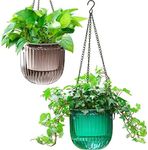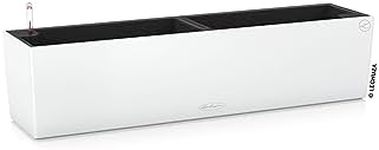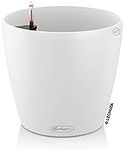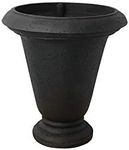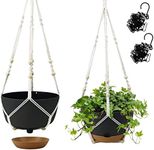Buying Guide for the Best Self Watering Planters
Choosing the right self-watering planter can make plant care much easier, especially if you have a busy lifestyle or want to ensure your plants get consistent moisture. The key is to match the planter’s features to your plant’s needs and your own habits. Understanding the main specifications will help you pick a planter that keeps your plants healthy and thriving with minimal effort.Reservoir CapacityReservoir capacity refers to how much water the planter can hold in its built-in tank. This is important because a larger reservoir means you can go longer between refills, which is great if you travel often or tend to forget watering. Small reservoirs (under 1 liter) are suitable for small plants or herbs and need more frequent refilling. Medium reservoirs (1-3 liters) work well for medium-sized houseplants and can last about a week. Large reservoirs (over 3 liters) are best for big plants or outdoor use, providing water for up to two weeks or more. Choose a reservoir size based on how often you want to refill and the water needs of your plants.
Wicking SystemThe wicking system is the method by which water moves from the reservoir to the plant’s roots. This is crucial because it determines how evenly and efficiently your plant gets watered. Some planters use cotton or synthetic wicks, while others have a soil column or capillary mat. Simple wick systems are good for small plants and are easy to maintain, but may not deliver enough water for thirstier plants. More advanced systems with multiple wicks or soil columns are better for larger or more demanding plants. Consider the type of plants you have and whether they need steady, consistent moisture or can tolerate some drying out.
Overflow ProtectionOverflow protection prevents excess water from building up in the reservoir, which can lead to root rot. This feature is important for plant health, especially if you tend to overwater. Some planters have a drainage hole or an overflow spout that lets extra water escape. Basic models may not have this, so you’ll need to be more careful when filling. If you’re new to self-watering planters or want extra peace of mind, look for a model with clear overflow protection to keep your plants safe.
Water Level IndicatorA water level indicator shows you how much water is left in the reservoir, making it easy to know when to refill. This is helpful because it takes the guesswork out of plant care and helps prevent both over- and under-watering. Some indicators are simple floats, while others are clear windows or gauges. If you want low-maintenance care or have trouble remembering when to water, a planter with a clear, easy-to-read indicator is a smart choice.
Material and DurabilityThe material of the planter affects its durability, weight, and appearance. Common materials include plastic, ceramic, and metal. Plastic planters are lightweight, affordable, and often more durable for outdoor use, but may not look as stylish. Ceramic planters are heavier and more decorative, but can break more easily and may not be ideal for large outdoor plants. Metal planters are sturdy and modern-looking, but can heat up in the sun. Choose a material that fits your style, where you’ll place the planter, and how much you’ll move it around.
Size and ShapeThe size and shape of the planter should match the type and size of the plant you want to grow. A planter that’s too small can restrict root growth, while one that’s too large may hold too much water and risk root rot. Tall, narrow planters are good for deep-rooted plants, while wide, shallow ones suit herbs or succulents. Think about your plant’s mature size and root system, and pick a planter that gives it enough room to grow without overwhelming it with excess soil or water.


